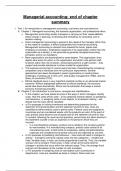Resume
End of chapter summary Managerial accounting - BA business economics
- Cours
- Managerial Accounting
- Établissement
- Vrije Universiteit Brussel (VUB)
This is the end of chapter summary for business economics. Book: Introduction to Management Accounting, 17th edition, global edition ISBN: 978-1-292-41270-2 (e-book)
[Montrer plus]



